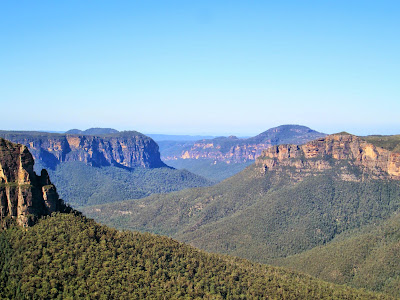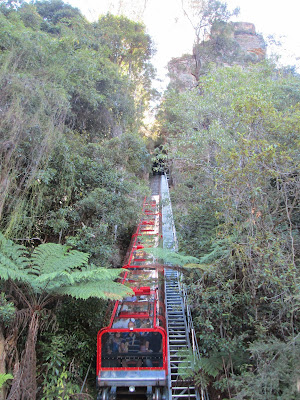Following the wonderful reunion with friends and former teaching colleagues in Goulburn on the evening of March 17, I caught a train the next day to Sydney.
The train journey from Goulburn to Sydney takes about three hours. It's one that I always enjoy as it passes through the beautiful countryside of the Southern Highlands, including the townships of Exeter, Bowral, Moss Vale, and Mittagong.
In Sydney I was reunited with my friend Joan, who traveled with me from Minnesota to Australia at the beginning of March and has shared some wonderful times with me and my family – in the Hunter Valley, in Port Macquarie and in Melbourne.
Above: With Joan on the rooftop of the Regents Court Apartments in Sydney's Kings Cross district. As you can see from this post's opening image, the rooftop garden of Regents Court affords an impressive view of "The City."
On Thursday, March 19, Joan and I traveled with my friend Julian to the Blue Mountains, located just west of Sydney.
Notes Wikipedia:
The Blue Mountains is a mountainous region in New South Wales, Australia. It borders on Sydney's metropolitan area, its foothills starting about 50 kilometres (31 mi) west of the state capital. The public's understanding of the extent of the Blue Mountains is varied, as it forms only part of an extensive mountainous area associated with the Great Dividing Range.
The Blue Mountains are a dissected plateau carved in sandstone bedrock. They are now a series of ridge lines separated by gorges up to 760 metres (2,490 ft) deep. The highest point in the Blue Mountains, as it is now defined, is an unnamed point with an elevation of 1,189 m (3,901 ft) seven kilometres north-east of Lithgow. However, the highest point in the broader region once considered to be the Blue Mountains is Mount Bindo, elevation 1,362 m (4,469 ft).
. . . When Europeans arrived in Australia, the Blue Mountains had already been inhabited for several millennia by the Gundungurra people, now represented by the Gundungurra Tribal Council Aboriginal Corporation based in Katoomba, and, in the lower Blue Mountains, by the Darug people, now represented by the Darug Tribal Aboriginal Corporation.
The Gundungurra creation story of the Blue Mountains tells that Dreamtime creatures Mirigan and Garangatch, half fish and half reptile, fought an epic battle which scarred the landscape into the Jamison Valley.
Arthur Phillip (1738-1814), the first governor of New South Wales, first glimpsed the extent of the Blue Mountains from a ridge at the site of today's Oakhill College, Castle Hill. He named them the Carmarthen Hills, 'some forty to sixty miles distant..." and he reckoned that the ground was "most suitable for government stock."
The first documented use of the name Blue Mountains appears in Captain John Hunter’s account of Phillip’s 1789 expedition up the Hawkesbury River. Describing the events of about 5 July, Hunter wrote: "We frequently, in some of the reaches which we passed through this day, saw very near us the hills, which we suppose as seen from Port Jackson, and called by the governor the Blue Mountains." During the nineteenth century the name was commonly applied to the portion of the Great Dividing Range from about Goulburn in the south to the Hunter Valley in the north, but in time it came to be associated with a more limited area.
The native Aborigines knew two routes across the mountains: Bilpin Ridge, which is now the location of Bells Line of Road between Richmond and Bell, and the Coxs River, a tributary of the Nepean River. It could be followed upstream to the open plains of the Kanimbla Valley, the type of country that farmers prize.
European settlers initially considered that fertile lands lay beyond the mountains, as was China in the belief of many convicts, but that this didn't matter much, since the mountains were impassable. This idea was, to some extent, convenient for local authorities. An "insurmountable" barrier would deter convicts from trying to escape in that direction.
A former convict, John Wilson, may have been the first European to cross the Blue Mountains. It is also believed that Mathew Everingham, 1795, may have also been partly successful based on letters he wrote at the time which came to light in the late 1980s. Wilson arrived with the First Fleet in 1788 and was freed in 1792. He settled in the bush, living with the Aborigines and even functioning as an intermediary between them and the settlers. In 1797 he returned to Sydney, claiming to have explored up to a hundred miles in all directions around Sydney, including across the mountains. His descriptions and observations were generally accurate, and it is possible that he had crossed the mountains via the southern aspect at the Coxs River corridor, guided by the Aborigines.
Above: The Three Sisters, undoubtedly the most famous landmark of the Blue Mountains.
Notes Wikipedia:
The Three Sisters is a rock formation in the Blue Mountains of New South Wales, Australia, on the north escarpment of the Jamison Valley. They are close to the town of Katoomba and are one of the Blue Mountains' best known sites, towering above the Jamison Valley. Their names are Meehni (922 m), Wimlah (918 m), and Gunnedoo (906 m).
. . . The commonly told legend of the Three Sisters is that three sisters (Meehni, Wimlah and Gunnedoo) lived in the Jamison Valley as members of the Katoomba tribe. They fell in love with three men from a neighbouring tribe (the Nepean tribe), but marriage was forbidden by tribal law. The brothers were not happy to accept this law and so decided to use force to capture the three sisters. A major tribal battle ensued, and the sisters were turned to stone by an elder to protect them, but he was killed in the fighting and no one else could turn them back. This legend is claimed to be an Indigenous Australian Dreamtime legend.
However, Dr Martin Thomas, in his work The Artificial Horizon: Imagining the Blue Mountains, clearly shows that the "aboriginal" legend is a fabrication created by a non-Aboriginal Katoomba local, Mel Ward, presumably to add interest to a local landmark. The story originated in the late 1920s or early 1930s and is unknown prior to that date.
The Aboriginal traditional owners, the Gundungurra, have a legend that includes the Sisters rock formation.
Above: Descending into the Jamison Valley.
Notes Wikipedia:
The Jamison Valley stretches north-south from just outside of Katoomba to the Mount Solitary ridge; in this direction it is approximately 4 kilometres (2.5 mi) long. From west to east, it stretches from Narrow Neck Plateau to Kings Tableland, making it approximately 10 kilometres (6.2 mi) wide.
Like the entire Sydney and Blue Mountains region, the valley is a sandstone area, characterised by steep sandstone cliffs. Deeper into the soil there is a layer of shale, which is softer than the sandstone. As this layer of shale was eroded by the watercourses, it collapsed and brought the sandstone down with it, creating the characteristic sandstone valleys and canyons of the Blue Mountains, of which the Jamison Valley is one.
The valley is densely forested, with eucalypt forest over most of its expanse and occasional pockets of semi-rainforest in gullies, where water is concentrated. The northern escarpment is deeply serrated, having been carved up by watercourses over millions of years.
. . . The only mountain in the valley is Mount Solitary [right], which sprawls across the south of the valley from west to east. It is joined to Narrow Neck Plateau by a low ridge which is also the site of the Ruined Castle, a rock formation that is popular with bushwalkers.
Above and below: In the Blue Mountains' Jamison Valley – Thursday, March 19, 2015.
Above and below: The Hydro Majestic Hotel in Medlow Bath.
Notes Wikipedia:
The Hydro Majestic Hotel was developed by Sydney businessman, Mark Foy in the early years of the twentieth century and was the main economic activity in the area, until bushfires nearly destroyed the hotel on December 8, 2002.
There is an elaborate network of walking tracks, which were developed in the bushland between the hotel and the escarpment of the Megalong Valley. The tracks offer scope for many fine bushwalks and views of the Megalong Valley.
The hotel received heritage listing in 1984. After many decades of decline and neglect the Hydro Majestic underwent a series of refurbishments during the 1990s. The Accor hotel group became associated with the hotel from about 2002 until 2006 and then a smaller Malaysian based group took over the running of the hotel, borrowing the name "Hydro Majestic" to brand their other hotels in Asia. In 2008 the hotel was closed for refurbishment, with the new owners restoring the hotel and adding new facilities.
Above and below: Gorse Valley as seen from Govetts Leap Lookout.
It's said that Sir Arthur Conan Doyle was inspired to write The Lost World after a visit to the Blue Mountains in the early years of the twentieth century. And looking at the view above from Govetts Leap, one can understand why.
Back in Sydney that night, Joan treated Julian and I to a show at the Sydney Opera House (below): a spirited performance by Sinéad O'Connor. That evening was also Joan's last night in Australia. She flew back to the U.S. the next day.
Above and below: Views (inside and out) of the Sydney Opera House (and the Sydney Harbour Bridge).
See also the previous Wild Reed posts:
• Australian Sojourn, March 2015: Part 1 – Brooklyn and Morpeth
• Part 2 – Port Macquarie, Wingham, and Ellenborough Falls
• Part 3 – Roving Sydney's Eastern Beaches with Raph
• Part 4 – The Sydney Gay and Lesbian Mardi Gras
• Part 5 – Watsons Bay, Camp Cove and the Sydney Heads
• Part 6 – Family Time in Melbourne
• Part 7 – The Great Ocean Road
• Part 8 – A Wedding in Melbourne
• Part 9 – A Reunion in Goulburn
• Return to Oz . . . Sydney to Be Exact! (2014)
• An Afternoon on the Harbour (2012)
• Leichhardt (2012)
• Sydney Sojourn (2010)
• Strathfield (2009)
• "Harbour City" Sights (2008)
• Newtown (2008)
• Travelin' South (Part 1) (2006)
• Southern Highlands (2006)
Images: Michael J. Bayly.











.JPG)










.JPG)




No comments:
Post a Comment